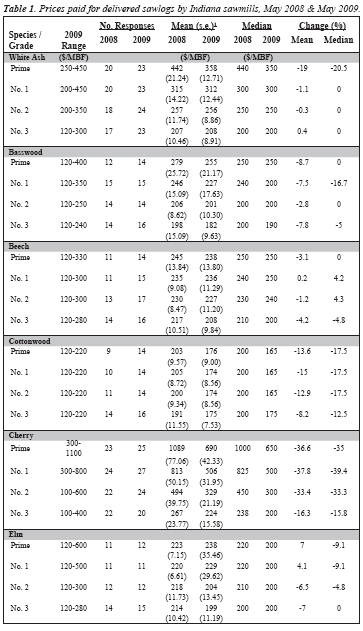
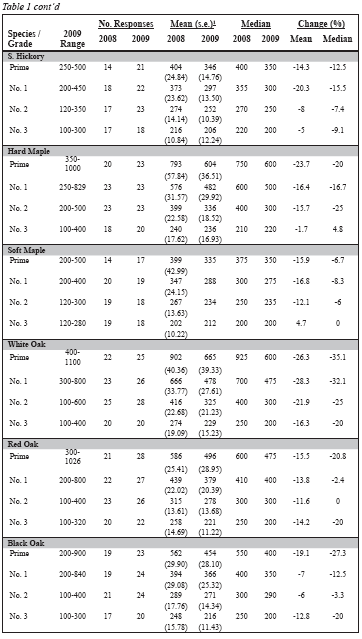
Fall 2009
Volume 18 No. 3
2009 Indiana Forest Products Price Report and Trend Analysis
William L. Hoover & Greg Preston
Survey Procedures and Response
Data for this survey was obtained by a mail survey of all known saw and veneer mills in Indiana. The survey was conducted by the Indiana Agricultural Statistics service. The prices reported are for logs delivered to the log yards of the reporting mills and concentration yards. This report is intended to be used as an indication of price trends, not for the appraisal of logs or standing timber (stumpage). Data is collected once a year and log prices are constantly changing. Standard appraisal techniques by those familiar with local market conditions should be used to obtain estimates of current market values for particular stands of timber or lots of logs. Because of the small number of mills reporting logging costs, "stumpage prices" estimated by deducting the average logging and hauling costs, Table 3, from delivered log prices must be interpreted with caution.
The survey was mailed to 212 mills. There was an initial mailing and one reminder postcard sent to non-respondents. Mills not responding were contacted by enumerators of the Indiana Agriculture Statistics Service. Purdue�s Department of Forestry and Natural Resources pays for this assistance using funds from its John S. Wright Endowment, not from public funds.
Seventy-three mills reported some useable data, compared to 88 last year and 102 in 2007. Six sawmills and 1 veneer mill responded that they went out of business. Twenty-eight declined to provide data, 11 were returned for bad addresses, and 4 reported that they didn�t buy logs. Thus 123 mills were accounted for making the overall response rate 58 percent, slightly above last year�s 54 percent.
The number of mills contributing price data for each product is shown in the fourth column in Tables 1 to 4. Fifty-one mills reported their 2008 total board-foot production, compared to 56 in 2007. Twelve mills reported producing 500 thousand board feet (MBF) or less. Total production for the reporting mills was 157 million compared to 175 million in 2007, and 205 million in 2006. Again for 2008 the largest mill responding reported 20 million board feet of output.
The price statistics by species and grade don�t include data from small custom mills because most do not buy logs, or they pay a set price for all species and grades of pallet logs. They are, however, the primary source of data on the cost of custom sawing. Thus, the custom sawing costs reported in Table 3 do not reflect the operating cost of large mills.
Hardwood Lumber Prices
As this is written lumber inventories are low enough to justify increased output based on current order levels. Price upticks in certain species will occur while supply catches up, but will then level off unless demand increases above current levels. Log yards are at or near empty since log inventories had to be reduced. Efforts to bring supplies in are facing resistance from landowners who are waiting until stumpage prices increase, and availability of logging services. An advantage of the logging business, especially in the corn belt where firms are small, is that operators can come and go with the market. But, the number leaving the business this go-round because of the severity and length of the recession will severely delay the response of the logging industry. The likely response will be a proportionately larger increase in delivered log prices than in stumpage.
Sawlog Prices
The number of mills reporting prices was up slightly compared to 2008. Sawlog prices, Table 1, were down across all species. Reflecting lumber price trends, the premium species were down the most, in the 15% to 30%, compared to less than 10 percent for the non-premium species. The lowest grade in almost all species increased the least, reflecting different markets for low grade lumber, and tie and cants. The largest declines were for black cherry, white oak, and black walnut. Red oak has been declining since 2002 when it peaked at $856 per MBF for prime logs. This year�s $496 is a 42 percent drop. In comparison, prime black walnut is down 15 percent from its peak in 2005.


Softwood Logs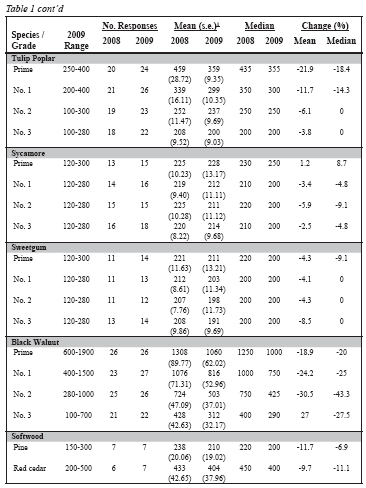
The average for the seven mills reporting pine sawlogs was down 11.7 percent, $210 compared to $238 in 2008. The niche market for red cedar logs continues, down 9.7 percent, from $450 to $400 per MBF.
Veneer Log Prices
Veneer log prices were down more than sawlogs. Small prime walnut was down about 15 percent, larger prime logs were down over 30 percent. Select black walnut was down 25 to 60 percent. White oak was down 20 percent or more. Black cherry was down 20 to 60 percent.
Implications
We find little reason to expect a rapid recovery in the hardwood industry. Stumpage buyers will be much more active going forward, but many mills will not be able to fund the large standing inventories they�ve typically kept. Lead times from purchase to harvest will be in the 2 to 3 months, compared to over a year when capital availability and cash flow were better.
Stumpage buyers will be offering slightly higher prices to make and close deals, but potential sellers are unlikely to know this. Most timber owners make decisions based on their overall perception of market conditions, not specific market conditions.
A key will be when consulting foresters perceive that prices
have recovered sufficiently to justify putting clients timber up for sale. There
is a backlog of clients waiting for a sell recommendation from their consultant.
This sector will become active only after buyers have worked through the easily
reached direct sale opportunities available to them. There will be many
fundamental changes in the hardwood industry in Indiana over the next decade.
After recovering from this recession production will go back on the longer run
downward trend. This will impact premium species and veneer logs more than the
industrial wood sector. The former is tied closely to housing and furniture,
while the later is tied to total industrial output. Export markets will make up
a greater share of the market for premium species in upper grades. The hottest
topic of conversation in the wood products and forestry communities is the
impact of the renewable energy sector on wood. We need to start collecting
additional information to track the impacts of this sector. Based on the data
available, there are few signs that energy demand is impacting wood prices. A
possible indication that the energy market is impacting by-product prices is
that sawdust and bark prices are coming together. We must point out that because
of the low number of responses for bark and sawdust prices any implications
drawn from them must be taken lightly. In addition, there is inconsistency in
how these prices are reported. Based on discussions with colleagues in the FNR
department here is our assessment of the impact of renewable energy demand on
wood products and forests in Indiana. Demand for sawdust will increase, driven
by the fuel pellet industry that is serving domestic markets and exporting to EU
countries. Bark will be substituted to a greater extent for sawdust in boilers
at wood products firms and paper mills. Hogged chips from debarked logs will
also go to pellet mills. Hogged chips from slabs with bark on will go to
boilers. The demand for bark for fuel will bump up against
the hardwood mulch market, capping the volume going for fuel.
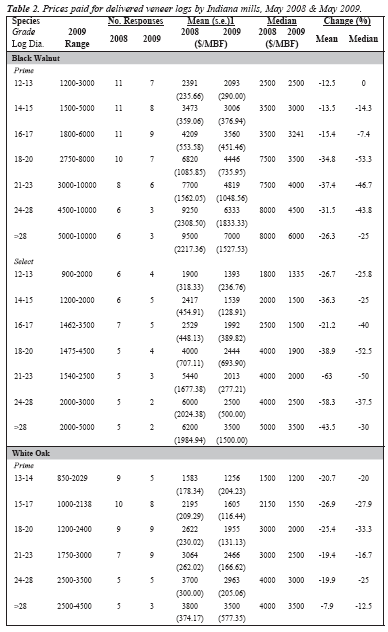
There will be a substantial increase in the demand for low grade small timber for pulpwood, pulp chips, wood pellets, and traditional firewood (split ricked wood). This demand will be met by harvesting smaller and lower grade stands. Cutover tracks with the potential to make 150 bushel or more of corn (or equivalent in soybeans) will be considered for conversion to row crop land. Lower quality tracts will be left to coppice for fuelwood on rotations as short as 25 years. Regeneration of such sites for 60 or more year rotations of quality hardwoods is unlikely. As the demand for land clearing increases the cost will come down as larger more efficient equipment is acquired by land contractors. Clearing cost is in the $2,000 to $3,000 per acre range. Tiling adds at least another $1,000.
Once the readily available supply of existing low grade stands is drawn down intensively managed short rotation fuelwood plantation with genetically improved stock will come into production. A cellulosic ethanol and methanol market will come into play in about five years. Given the low yield of current processes it�s possible that the price offered for wood will not be competitive with pellet and direct combustion markets.
What about the quality hardwood sector? As mentioned above we expect that the total demand for hardwood lumber for high end uses will continue a long-term decline. Existing stands with good stocking of premium species have a good chance of staying in timber. The financial return will be adequate to cover taxes and holding costs, and provide a real rate of return equivalent to the long-term stock market average but a somewhat lower level of short-term risk. "Owner occupied woodland" will play a greater role in the supply of quality hardwood. These are 5 to perhaps 30 acre tracts on which the owner�s principal residence is located. These folks don�t want to harvest in the near term, allowing the timber to grow, albeit, not managed
to provide the best possible rate of return. As these tracts change hands it�s increasingly likely that the seller or in many cases their estate will find the liquidation of some portion of the timber wealth an irresistible option. Except for part time commercial and home-use firewood cutters we don�t expect commercial TSI cuttings for fuelwood to have a significant impact. This would need to be reevaluated if smaller scale automated harvesting equipment, such as feller-bunchers and forwarders come on the market.
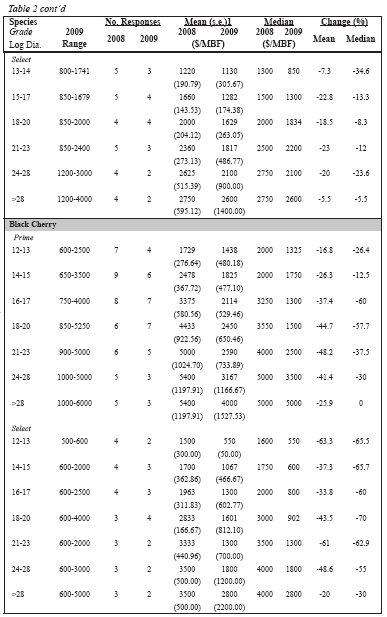
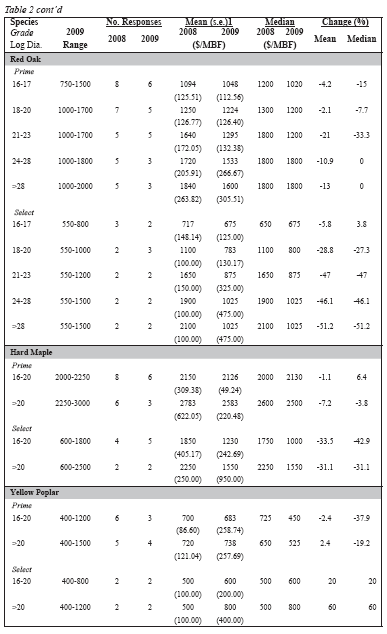
Custom Costs
The number of mills reporting custom costs was down by about thirty percent compared to last year. The average cost reported for custom sawing was $297 per MBF, up from $274 last year, Table 3. The mills reporting are primarily small "local" mills, many portable. Two mills reported on a per hour basis. The average was $45, down from $62 last year. Average logging cost was $131 per MBF, about the same as last year�s $138. The reported cost of hauling was $50, back to the level reported in 2007, but down 50 percent from last year. The calculated cost per MBF per mile also was down about fifty percent, going from $1.98 to $1.00.
The average logging cost of $131 per MBF plus a hauling cost of $1.00 per MBF per mile for the 67 mile average haul equates to a cost of about $200 to put a thousand board feet of logs on a mill deck, compared to $227 per MBF in 2008. With the average price of pallet logs at $226, Table 4, the so-called "conversion surplus" is $26 per MBF or 2.6 cents a board foot.
Miscellaneous Products
The number of mills reporting prices for miscellaneous products was down on about fifteen percent. The average price paid for cant logs, i.e. logs sawn for pallet lumber, railroad ties, and industrial and trucking blocking was $226 per MBF, down from $248 last year, Table 4. The price per ton decreased to $31 from $39 in 2008. Pulp chip prices decreased from $26 per ton to $22, while pulpwood decreased from $36 to $31 per ton. Any declines in mill residue must be interpreted with suspicion. The decline in sawmill production in the thirty percent range on average has reduced residue availability. Anecdotal reports indicate that some mills are short of boiler fuel needed to power their dry kilns.
Indiana Timber Price Index
The delivered log prices collected in the Indiana Forest Products Price Survey are used to calculate the delivered log value of typical stands of timber. This provides trend-line information that can be used to monitor long-term price trends for timber. The species distribution and log quality weights used to calculate the weighted averages at http://www.ces.purdue.edu/extmedia/FNR/FNR-177-W.pdf.
Average Stand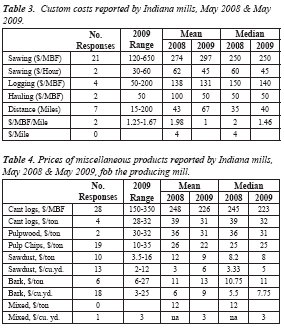
The nominal weighted average price for a stand of average quality decreased from $433.7 last year to $358.8 per MBF. This is a 17.3 percent drop off, the largest decline since this price report started in 1957. The next largest decline was 10.7 percent from 1984 to 1985. Remember that this series is based on delivered log prices, not stumpage prices.
The deflated or real price decreased from $244.9 to $207.9, 15.1 percent drop off. This decrease continued the slow decline in the trend line rate for the real price series. It went from 1.02 percent simple compound rate of interest last year to 0.95 percent this year.
The new equation for the trend line for the 1957 to 2009 period is,
Avg. Stand Real Price = 173.66 + 2.00 x T, where, T=1 for 1957, 2 for 1958 . . . 53 for 2009
A linear trend line should be used to project timber prices, as discussed in greater detail in Purdue University Station Bulletin No. 148. Although it's easier to simply plug the average annual compound rate of increase value into the compound interest
15 years give unrealistic results. Real prices can't increase exponentially for long periods of time. The market adjusts by using more substitutes for "real wood" and consumers being willing to accept substitutes.
Quality Stand
The nominal weighted average price for a high quality stand decreased 20.4 percent from $643.2 in 2008 to $512.0 per MBF. The average real price series for a high quality stand decreased 18.3 percent from $363.2 in 2008 to $296.6 per MBF.
The average annual compound rate of increase for the trend line declined from 1.33 percent per annum in 2008 to 1.25 percent this year. The equation for the trend line is,
Quality Stand Real Price = 207.62 + 3.79 x T, where T=1 for 1957, 2 for 1958 . . . 53 for 2009
Dr. William Hoover is a Professor of Forestry in the Department of Forestry and Natural Resources at Purdue University. Greg Preston is the State Statistician for the Indiana Agricultural Statistics Service in West Lafayette, Indiana.